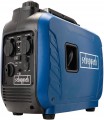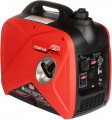Rated power
The rated power of the generator is the highest power supply that the unit is capable of delivering without problems for an unlimited time. In the “weakest” models this figure is
less than 1 kW, in the most powerful –
50 – 100 kW or even
more ; and generators with welding capabilities (see below) typically have power ratings ranging from
1 – 2 kW to
8 – 10 kW.
The main rule of choice in this case is this: the rated power must not be lower than the total power consumption of the entire connected load. Otherwise, the generator simply will not be able to produce a sufficient amount of energy, or it will work with overloads. However, to determine the minimum required generator power, it is not enough to simply add up the number of watts indicated in the characteristics of each connected device - the calculation method is somewhat more complicated. Firstly, you need to take into account that only the active power of various equipment is usually indicated in watts; In addition, many AC electrical appliances consume reactive power (the "waste" power consumed by coils and capacitors when operating at that power). And the actual load on the generator depends precisely on the total power (active plus reactive), indicated in volt-amperes. There are special coefficients and formulas for its calculation.
...The second nuance is related to the power supply of devices in which the starting power (and, accordingly, the power consumption at the moment of switching on) is significantly higher than the rated one - these are mainly devices with electric motors such as vacuum cleaners, refrigerators, air conditioners, power tools, etc. You can determine the starting power by multiplying the standard power by the so-called starting coefficient. For one type of equipment it is more or less the same - for example, 1.2 - 1.3 for most power tools, 2 for a microwave, 3.5 for an air conditioner, etc.; More detailed data is available in special sources. Starting characteristics of the load are necessary, first of all, to assess the required maximum power of the generator (see below) - however, this power is not always given in the characteristics; often the manufacturer indicates only the rated power of the unit. In such cases, when calculating for equipment with a starting coefficient of more than 1, it is worth using the starting power, and not the rated power.
Also note that if there are several outlets, the specific division of the total power among them may be different. This point should be clarified separately - in particular, for specific types of sockets (for more details, see “230 V sockets”, “400 V sockets”).Motor type
Model name of the engine installed in the generator. Knowing this name, you can, if necessary, find detailed data on the engine and clarify how it meets your requirements. In addition, model data may be needed for some specific tasks, including maintenance and repair.
Note that modern generators are often equipped with
branded engines from famous manufacturers: Honda, John Deere, Mitsubishi, Volvo, etc. Such engines are more expensive than similar units from little-known brands, but this is offset by higher quality and/or solid warranty conditions , and in many cases, the ease of finding spare parts and additional documentation (such as manuals for special maintenance and minor repairs).
Engine size
The working volume of the engine in a gasoline or diesel generator (see "Fuel"). Theoretically, more volume usually means more power, but in fact, everything is not so clear. Firstly, the specific power strongly depends on the type of fuel, and in gasoline units, also on the type of internal combustion engine (see above). Secondly, similar engines of the same power can have different volumes, and there is a practical point here: with the same power, a larger engine consumes more fuel, but by itself it can cost less.
Fuel consumption
Fuel consumption of a gasoline or diesel generator, and for combined models — when using gasoline (see "Fuel").
A more powerful engine inevitably means more fuel consumption; however, models with the same engine power may differ in this indicator. In such cases, it is worth considering that a model with a lower flow rate usually costs more, but this difference can quickly pay off, especially with regular use. In addition, knowing the fuel consumption and tank volume, you can determine how long one refueling will last; at the same time, in inverter models at partial load, the actual operating time may be noticeably higher than the theoretical one, see "Alternator" for details.
Fuel tank volume
The volume of the fuel tank installed in the generator.
Knowing the fuel consumption (see above) and the capacity of the tank, you can calculate the operating time on one gas station (if it is not indicated in the specifications). However, a more capacious tank is also more bulky. Therefore, manufacturers choose tanks based on the general level and "voracity" of the generator — in order to provide an acceptable operating time without a significant increase in size and weight. So in general, this parameter is more of a reference than practically significant.
As for the numbers, in low-power models, tanks are installed for
5 – 10 liters, or even
less ; in heavy professional equipment, this figure can
exceed 50 liters.
Continuous operation time
The time during which the generator is guaranteed to operate without interruption.
This parameter is indicated exclusively for liquid fuel models with a built-in tank, and according to the simplest formula: tank capacity divided by fuel consumption. However, in some models, data may be provided for a certain load level (which is specified in the notes); at a higher or lower load, the operating time will be shorter or longer, respectively. As for specific numbers, in most modern generators the operating time is
up to 8 hours - this is quite enough for backup power and occasional use. More reputable models are capable of working for
8 – 12 hours, and an indicator of
13 hours and above is typical mainly for professional solutions.
We also note that, theoretically, many generators can be refueled without shutting down, but in practice it is better to take breaks and not exceed the stated time of continuous operation - this will avoid overheating and increased wear.
Number of sockets (230/400 V)
The total number of 230 and/or 400 V outlets provided in the generator design.
This number corresponds to the number of devices that can be simultaneously connected to the generator without the use of splitters, extension cords, etc. Moreover, if we are talking about a three-phase model (see “Output voltage”) with different types of sockets, it would not hurt to specify the number of both separately, since the set may be different in different models. For example, a unit for which
3 sockets are declared may have 1 three-phase connector and 2 single-phase, or 2 three-phase and 1 single-phase. In general, the most limited modern generators have only
1 outlet, although models with
2 are more common; and in the most powerful models this number can be
4 or higher.
Let us also recall that the possibilities for connecting various devices are limited not only by the number of sockets, but also by the rated power of the generator (for more details, see above).
Sockets 230 V
The number of 230 V sockets provided in the design of the generator, as well as the type of connectors used in such sockets.
The type of connector in this case is indicated by the maximum current that is allowed for the outlet — for example, "2 pcs at 16 A". The most popular options for 220-volt outlets are
16 A,
32 A and 63 A. We emphasize that the amperes in this designation are not the actual current that the generator can produce, but the outlet's own limitation; the actual value of the current strength is usually noticeably lower. Simply put, if, for example, the generator has a 32 A socket, the output current on it will not reach 32 A; and the specific number of amperes will depend on the rated and maximum power of the unit (see above). So, if for our example we take a rated power of 5 kW and a maximum of 6 kW, then such a generator can deliver less than 5 kW / 230 V = 22.7 A nominally and 6 kW / 230 V = 27 to a 230 V socket, 3 And at the peak. And if the power has to be divided between several outlets, then it, accordingly, will be even less.
As for specific types of connectors, the higher the current allowed for the outlet, the higher the requirements for its reliability and quality of protection. Thus, usually, smaller power plugs can be connected to higher power sockets (directly or through an adapter), but not vice versa. And if there are several sockets, by their type it is pos
...sible to estimate with a certain certainty the distribution of the entire power of the generator between them: between two identical sockets, this power is usually divided equally, and more power is allocated to the socket for a larger number of amperes. However, specific details on this matter should be clarified in each case separately; also consider 400 V sockets, if available (see below).USB charging port
The generator has
a USB connector(one or more) for charging various devices. Most modern smartphones and tablets can be charged from USB, and this charging method is also found in many other equipment - from cameras and flashlights to electric screwdrivers and radio-controlled models. The standard supply voltage through this connector is 5 V, but the power may be different, it should be specified separately.

